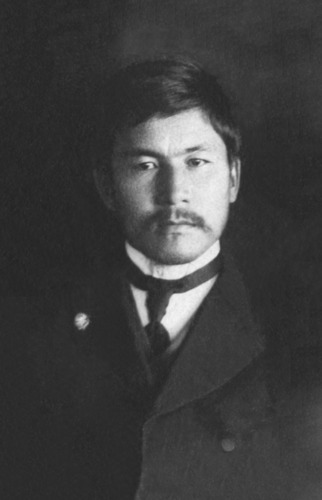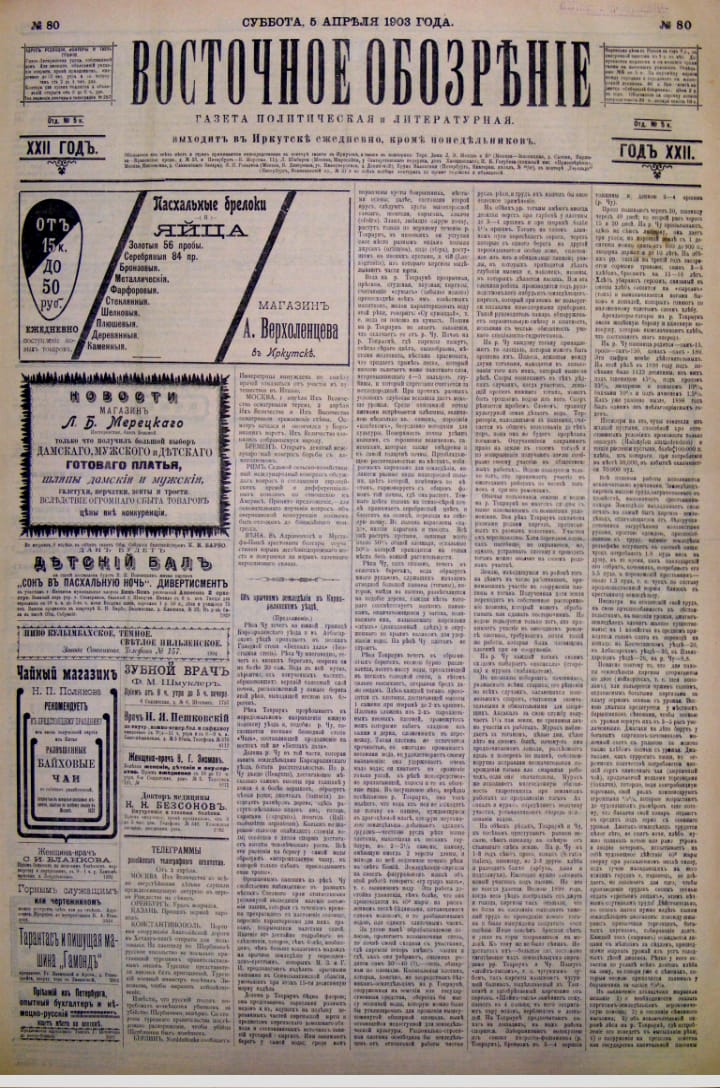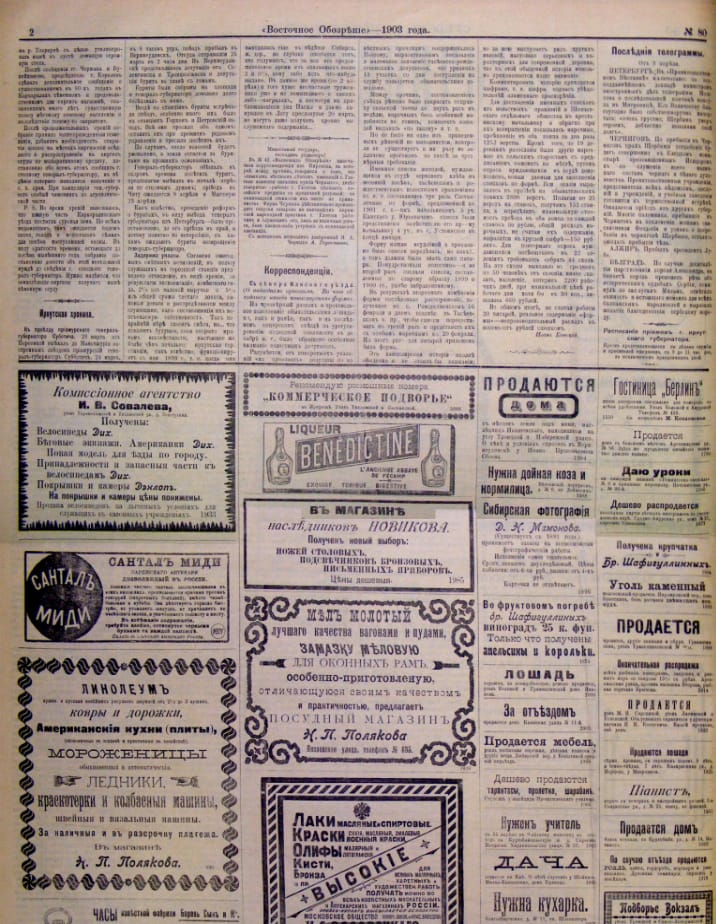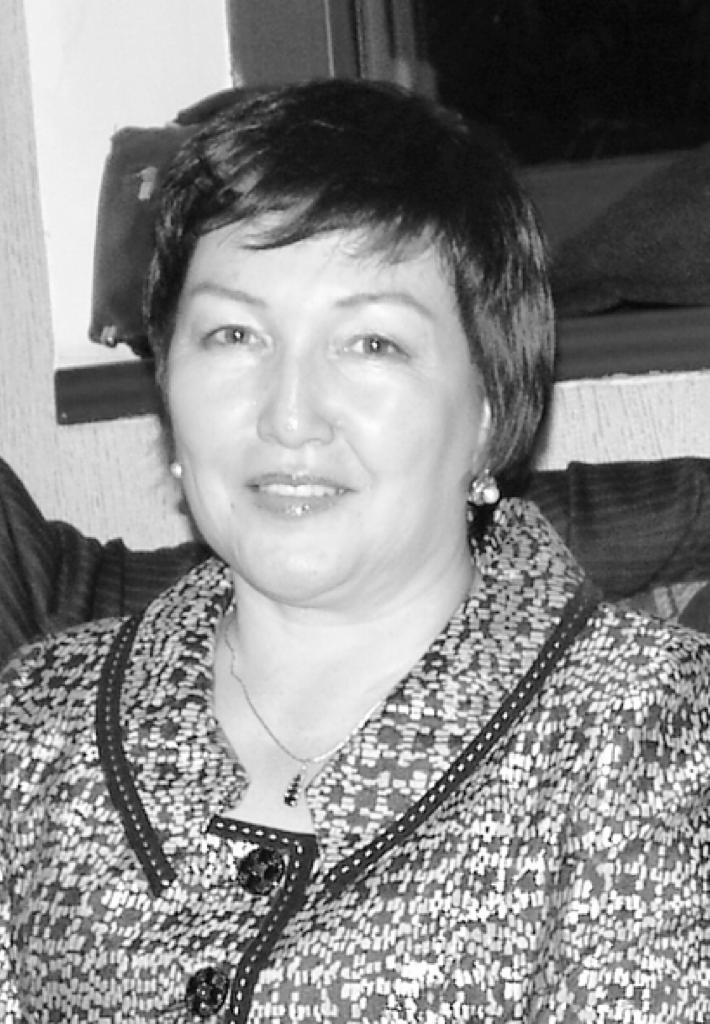...The newspaper is literary and political – so it was indicated in the output data of the Irkutsk edition of the Eastern Outlook. The publication had weight because its origins lie in St. Petersburg, where it was founded in 1882 by a famous scientist, a native of Siberia N. Yadrintsev. Later, in 1888, the publication was moved to the city of Irkutsk, where it was published until its official closure in 1906, as "disloyal" to the government.
 Alikhan BUKEIKHANOVBy specialization, this publication was educational and practical at the same time – the newspaper published articles on geography, history, ethnography and the economy of Siberia, conscientiously informed readers about secular news, as well as about scientific expeditions and research. This was important at the stage of self-determination of Siberia as a special economic zone and a multicultural region with a special status, which had to be defended through publication activity. As it turned out, one of the ethnographic articles of Alikhan Nurmukhamedovich Bukeikhanov was posted on the pages of the "Eastern Review", the history of its appearance is not quite typical, therefore we will focus on this below [1]. It was possible to find scanned copies of the newspaper in the library of Tomsk State University [2]. Copies of the newspaper are also stored in book depositories in Irkutsk [3].
Alikhan BUKEIKHANOVBy specialization, this publication was educational and practical at the same time – the newspaper published articles on geography, history, ethnography and the economy of Siberia, conscientiously informed readers about secular news, as well as about scientific expeditions and research. This was important at the stage of self-determination of Siberia as a special economic zone and a multicultural region with a special status, which had to be defended through publication activity. As it turned out, one of the ethnographic articles of Alikhan Nurmukhamedovich Bukeikhanov was posted on the pages of the "Eastern Review", the history of its appearance is not quite typical, therefore we will focus on this below [1]. It was possible to find scanned copies of the newspaper in the library of Tomsk State University [2]. Copies of the newspaper are also stored in book depositories in Irkutsk [3].
Why Irkutsk? The settlement is quite remote from the Kazakh steppes, although telegraph and postal communications were maintained along the route of the Trans-Siberian Railway at the beginning of the twentieth century. We were interested in this reference to the previously unknown in the published works of A. N. Bukeikhanov and historiography, his publication in 1903 in the newspaper "Eastern Review" (hereinafter – IN). It means that motivation and authoritative connections with the editorial board were necessary for this. The intermediary between Bukeikhanov and the editorial board of the "Eastern Review" could well be a friend of Alikhan Nurmukhamedovich, a well-known Siberian researcher, an authoritative historian, folklorist, ethnographer Grigory Nikolaevich Potanin. The views of Potanin and the founder of the newspaper Yadrintsev coincided regarding the fate of Siberia. The editor of "VO" at that time was I. I. Popov, who shared the views of the People's Will.
It is interesting that we found the mention of the publication of the Kazakh researcher during a business trip to Tashkent, in the rare collection of the Library of the Research Institute of Oriental Studies of the Republic of Uzbekistan, and in the book, which in turn became a rarity. The book is called "Materials for bibliography on ethnography and anthropology of Kazakhstan and the Central Asian Republics" (L., 1927) [4].
The 1927 edition is essentially academic, representing a set of pre–revolutionary and Soviet publications on the history and ethnography of Kazakhstan and the republics of Central Asia. Since this book was published before the beginning of mass repressions in the Soviet Union, accordingly, there are references to publications that subsequently became unavailable or remained out of sight of scientists for many years. Many authors were subjected to illegal Stalinist repressions. Under No. 1627, the book contains the researched publication of Bukeikhanov in co-authorship with Chermak [5]. Textual analysis of the article gave a lot of information about the reason for publication in the newspaper, popular among segments of the population who are, in general, oppositional towards the power structures.
The value of the find is seen as a) a sample of scientific and practical implementation of empirical research by them (the Shcherbina expedition), and b) an example of participation in a sharp polemic with opponents and a firm position of the leader of the Alash, who wanted to defend the right of his people to a decent life to the end. The content analysis of the article reflected the extensive knowledge of the authors in the details of the Kazakh economic and cultural type and the Kazakh language, which they note as rich in images, conveying the nuances of life.
So, on April 1, 1903, the 76th issue was published. In it, in addition to announcements of Easter events, the first part of an extensive report was printed, which took place on February 25, 1903 in Omsk, the speakers L. Chermak and A. Bukeikhanov called their message "On the arable farming of the Kirghiz of Karkarala county on the rivers Chu and Tokraun". It would seem that Irkutsk and Karkaralinsk are separated by huge distances, only travelers and narrow specialists had to hear about the ditches in Eastern Siberia.
Nevertheless, enthusiasts Chermak and Bukeikhanov (their specialization can be called in a modern way: ethnographers, anthropologists, agricultural sector experts), having examined one of the counties of Sary-Arka in Central Kazakhstan, managed to captivate the audience with their calculations. It was reported that "Karkaraly county is the most extensive of all 5 counties of Semipalatinsk region. 33,157 farms of Kirghiz nomads live in it on 182,430 square versts of area" (VO. 1903. No. 76, p. 2).
The editorial board of the "Eastern Review" commented on this message and the recommendations adopted "after a lengthy debate", which indirectly confirms the relevance of the topic raised by the authors. It was said that the expedition of the Ministry of Agriculture and State Property, organized in 1896 by "the famous veteran of Russian statistics F. A. Shcherbina for economic and statistical research of the steppe regions, in 1898, 19,616 farms were investigated in Karkaralinsky county, or 59.1%, or almost 2/3 of the entire population of the county" (IN 1903. No. 76, p. 2).
During the expedition, 3865, or 19.7% of farms engaged in agriculture, were also censored. Of the latter, 3244, or 84%, had irrigated arable land. The speakers explained that "aryk" is how the Kyrgyz (Kazakhs. – G. M.) call a ditch, hence "arychnoe", i.e. irrigated agriculture."
Using figures, Chermak and Bukeikhanov concluded that "the vital interests of about 10 thousand nomadic farms of the Karkaraly district are connected with the fate of agriculture in general, in particular," (p. 2). The topic interested readers with its unusual nature, since many Kazakhs then represented a nomadic ethnic group, the authors also cited statistics of settled settlements and arable farming in In Central Kazakhstan, as members of the Shcherbina expedition, they witnessed cardinal changes in the Steppe.
the Karkaraly district are connected with the fate of agriculture in general, in particular," (p. 2). The topic interested readers with its unusual nature, since many Kazakhs then represented a nomadic ethnic group, the authors also cited statistics of settled settlements and arable farming in In Central Kazakhstan, as members of the Shcherbina expedition, they witnessed cardinal changes in the Steppe.
The article is full of interesting facts from the history of the region, migration processes and ethnographic terms: for example, it says: "In the county, the arychno-agricultural culture existed even in an epoch remote from our time, as evidenced by the traces of old togans (the main drainage ditch) found along all the rivers of the south of the Karkarala county" (IN. 1903. No. 76, p. 2). The ancestral affiliation of Kazakh farmers was also identified: "The Kirghiz of the Jalair clan for a long time they lived on the Chu River, engaged in arable farming."
It is also curious that the historical stage of the liberation uprising of the Kazakhs under the leadership of Sultan Kenesary Kasimov is artfully embedded in the outline of the report, and the tone of the retelling is very friendly towards the character. This nuance is obviously introduced into the context of the report by A. Bukeikhanov, who knew the prerequisites of the Kenesary uprising well: "The time of Troubles of the 40s of the nineteenth century, when the brave Sultan of Kenesary stirred up the entire Kyrgyz steppe from one end to the other, finds the Jalairites peaceful ploughmen and forces them to abandon their arable land and native R. Chu, in order to escape among his relatives who lived within the current Kopalsky district of the Semirechensk region." Further, the fate of the Jalair clan and its migrations is outlined briefly: "The Jalair people, having lived here (in the Kopal district) for 25 years and having waited for the country to calm down, in the 70s of the last century, return to their native field again."
Another co-author L. Chermak from raznochintsev shared the views of the people's Will, and the figure of the rebellious Kenesary did not bother him at all, if not inspired. Chermak led one of the divisions of the Shcherbina expedition, knew Kazakh culture well and appreciated Bukeikhanov's abilities.
The next point on which the speakers stopped was the time of the appearance of the first dams and togans (man–made drainage channels from the main channel. – G. M.). "The first dam and togan on the Tokraun River was built in the 30s of the last century by a Kyrgyz of the Shubyrtbaly family Agybai, later a famous associate of Sultan Kenesary." It should be noted that when describing the artisanal hydraulic structures of the Kazakhs, Bukeikhanov did not miss the opportunity to recall Kenesary's associate, the famous batyr Agybai: "Agybai, having joined him (Sultan Kenesary), threw his togan. It went to the real farmers on the river . Tokraun". Thus, thanks to Bukeikhanov, the image of an economic man, and if necessary, a formidable defender of the disadvantaged, batyr Agybai, is imprinted in written history.
"Real farmers" meant "the poor, who for some reason lost the working cattle necessary for nomadism, who lost any opportunity to roam and the unsettled cattle breeders ... constantly cherishing a cherished dream - to get out of the servitude of the farmer "jataka". Actually, the following summaries attract attention: "The poor Kyrgyz are pioneers of agricultural culture", "In recent years, the number of grain sowers has been growing, which indicates not only the ease of falling, the instability of the nomads' cattle breeding economy, but also a new trend in its economic life itself, characterizing the more and more growing desire of the Kyrgyz for agriculture as a special trade."
When describing the Kazakh economy, the authors used the concepts of "salkyn" (life-giving coolness), "Sary-Arka" (yellow uval): "The Kirghiz "Sar-Arka" call the vast expanse of their steppes the basins of the pp. Nura, Ishim and Tyundyk are probably named after the yellow landscape of the kovyl steppe, which dominates here." The newspaper specifically provided explanations of Turkic terms and toponyms for readers.
The continuation of the publication was already published in No. 80 dated April 5, 1903. In terms of volume, the second part of the article is larger than the first part and occupies almost the entire area of the second and part of the third pages of the Eastern Review. The characteristic of the sources and valleys of the Chu and Tokraun rivers, soils using the toponyms "Betpak dala", "Chol" (Shol, anhydrous steppe) and the names of vegetation: djide, shengel, karagana, kzylcha, jusan, chiy is given. It was pointed out that a yurt is used in the Kazakh economy, parts of which are made by artisans from chia, and Kazakhs compare the water of the Tokraun River with their favorite drink "Su kumyzdai", that is, delicious (VO. 1903. No. 80, p. 1).
 The specifics of the Kazakh economy gave rise to such names as "atyz" – this was the name of a small dam at the end of the ditch ("horse trail"). Kazakhs also figuratively called the process of removing the underground riverbed on the Tokraun River "su suyramyz" (we take out the water). The authors conclude that it is necessary to build dams in order to retain thawed spring waters for subsequent irrigation. All these details indicate a good knowledge of the Kazakh way of life by the authors of the article, they recorded unusual expressions, neologisms that meant the transformation of consciousness and the emergence of technological innovations.
The specifics of the Kazakh economy gave rise to such names as "atyz" – this was the name of a small dam at the end of the ditch ("horse trail"). Kazakhs also figuratively called the process of removing the underground riverbed on the Tokraun River "su suyramyz" (we take out the water). The authors conclude that it is necessary to build dams in order to retain thawed spring waters for subsequent irrigation. All these details indicate a good knowledge of the Kazakh way of life by the authors of the article, they recorded unusual expressions, neologisms that meant the transformation of consciousness and the emergence of technological innovations.
"Water makes the border of the cultural land," Chermak and Bukeikhanov conclude, retelling the ways of solving land and water disputes in practice among the Kazakhs of the Chu and Tokraun valleys. "Water is used only by those who take part in the annual cleaning of togans and during its repairs." The authors of the publication pointed out that "on the Chu River, each togan chooses an "aksakal" (an old man) and a "muran" (an observer), the first makes the final decision in disputes, the second (Muran) constantly watches the togans ("performs the multi-complex duty of a hydraulic engineer"). Both establish the order of use of water, the aksakal receives 1.5 shares of land for his service. In this context, the observers noted the allocation of new social categories among the settled Kazakhs, who were kept by the community for the performance of certain duties for the care of water intakes (utilization of natural precipitation).
It is said about the method of cultivating the land: "They plow with a shoyin-thousand, i.e. with a cast-iron tooth (a kind of plow), so the Kyrgyz call a cast-iron shoe made in Tashkent and purchased by the Kyrgyz from the Sarts. A couple of oxen, camels and horses are harnessed to it. On Tokraun, they prefer to plow on horses." They sow millet, alfalfa, konak, barley, melons, etc., the harvest is taken to the "kirman" (current). "For plowing, Kyrgyz farmers mate in twos (moynortak, i.e. neck in half), or use someone else's cattle, given by rich Kyrgyz for a fee with grain from the harvest in autumn." Seeds were supplied by "bakalchi" (small traders, apparently, this is a derivative of "grocery").
The editorial comment to the article reflects a very friendly attitude to the material. There is an interest in the informative message being appreciated by subscribers.
The fact is that L. Chermak and A. Bukeikhanov did not just conduct a survey of the Kazakh economy, rather, even their information should have become the basis for making specific demands in order to improve the situation of impoverished Kazakhs. The editors made a postscript: "In conclusion, the speakers expressed their desire 1) to provide the Kyrgyz landowners with agronomic assistance; 2) to create a seed store; 3) to exclusively protect the forest on the river.Tokraune, where its destruction will lead to the drying up of the river; 4) on the construction of a capital dam on the river at the expense of the zemstvo or the state. Tokraun in order to dispose of the vast steppe now lying in emptiness (in the sense of "in vain")" (VO. 1903. No. 80, p. 2).
The report caused a heated debate, in particular, it was stated that "the chairman, Mr. Korolev, made an additional report about a seed and food store for Kyrgyz people that existed in the 80s in Karkaraly, which provided significant benefits to the local nomadic population for many years and was subsequently closed for some reason." "After a lengthy debate, the assembly adopted the above-mentioned wishes, adding the need to open a school in the places of Kyrgyz settlement and extend a loan on a land reclamation loan to the Kyrgyz, decided to inform G. To the steppe Governor-General, who is responsible for the care of the agricultural region. At the Office of the Governor-General there is a special official on the agronomic part."
Thus, following the results of the report in Omsk in February 1903, Bukeikhanov decided to promote more widely the empirically obtained information about Kazakh agriculture and the plight of the Kazakhs in the instance. This allows us to draw a preliminary conclusion that the publication of Bukeikhanov in the Irkutsk newspaper in April 1903 had a purposeful character. It was not so much a scientific report as a petition to the administration, with specific requirements: to pay attention to Kazakh settled farmers, it was during the period of mass resettlement of peasants from the central regions of Russia to the steppe regions. History has confirmed the correctness of the authors.
At the end of the material, the editorial board of the "Eastern Review" posted a comment: "P.S. During the debate, it turned out that the southern part of Karkaraly county suffered a severe winter. By all appearances, livestock deaths, famine and lack of seeds for sowing the coming spring are expected there. In view of the shortness of time remaining before sowing, the assembly decided to bring this urgent need to the attention of the Governor-General of the steppe. It is to be hoped that Kyrgyz farmers will now receive a seed loan" (VO. 1903. No. 80, p. 2).
Summarizing the above fragments from Bukeikhanov's voluminous article, attention should be paid to the geography of the counties surveyed by him, namely Karkaralinsky. It was there in the summer of 1905 during the traditional seasonal fair that the famous Karkaraly petition was discussed and adopted. The petition was signed by authoritative Kazakhs and contained demands regarding the distribution of land between the settlers and the indigenous population and other pressing points.
According to experts, variants and copies of the Karkaraly petition were sent to the editorial offices of the central Russian newspapers "Son of the Fatherland" and "Russian Vedomosti". In fact, the publication of 1903 for Bukeikhanov was a rehearsal for the coming stage of the civilized struggle for his ideals through periodicals and sending petitions. Having appreciated the power of the printed word, a few years later A. Bukeikhanov, together with A. Baitursynov and M. Dulatov, implements the idea of publishing the national newspaper "Kazakh" in Orenburg.
Accordingly, the publication in question in the newspaper "Eastern Review" in Irkutsk in the spring of 1903 may make adjustments to the chronicle of the movement of the Alash intelligentsia and the biography of A. N. Bukeikhanov. After all, it turns out that the idea of a public appeal to the administration, due to the difficult financial situation of the indigenous population, Bukeikhanov originated earlier than 1905. He experienced a certain influence of the Slavic friends around him, G. Potanin, L. Chermak, I. Popov, absorbed their opinions, at the same time forming his own worldview. It is known that Potanin supported Bukeikhanov during the creation of the Alash government in 1917.
The ability to make friends and share what they saw, to calmly argue their position, is distinguished by the publications of Alikhan Nurmukhamedovich. The style of his public speeches in print is unique, imaginative and logically verified. The language of the article is rich and saturated with ethnographic finds, figurative folk sayings, which decorated and shaded it.
The chronologically found article also gives grounds to revise some assessments of the political views of the Kazakh leader on the eve of 1905. In fact, 1905 in Soviet "Marxist" historiography was a "milestone" to which events on the ground were artificially attached. The discovery of a previously unknown article by A. Bukeikhanov and L. Chermak, in our opinion, allows us to date their determination to act in a civilized way, through the media, petitions, not 1905, but at least 1903. It is gratifying that even then Bukeikhanov and his supporters in the Russian-language periodical press raised acute issues of opening schools for the settled Kazakh population. The pedagogical path did not bypass him: in 1903, when the article was published, Alikhan, a graduate of the St. Petersburg Forestry Institute, managed to transfer knowledge to students of the Omsk Agricultural College (taught mathematics).
On the example of the civil position of the Kazakh public and political figure, publicist, ethnographer and teacher Alikhan Bukeikhanov, the noble path of the advanced intelligentsia of the East at the beginning of the twentieth century to national and cultural identity is crystallized.
LITERATURE
1. Chermak L., Bukeikhanov A. About arychny agriculture in the Kirghiz of the Karkaralinsky district // Eastern Outlook. 1903. No. 76, 80.
2. Eastern Review: literary and political newspaper – St. Petersburg; Irkutsk: published daily. See the Scientific Library of Tomsk State University. Fund of pre-revolutionary newspapers.
3. Irkutsk Regional Universal Scientific Library named after I. I. Molchanov-Sibirsky. Cipher VOBR/1903/76. "Eastern Outlook". 1903. No. 76, 80.
4. Materials for bibliography on ethnography and anthropology of Kazakhstan and Central Asian republics / Compiled by E. A. Voznesenskaya and A. B. Piotrovsky. Leningrad: Academy of Sciences of the USSR, 1927. 266 p.
5. Materials ... p. 151.


Comments powered by CComment